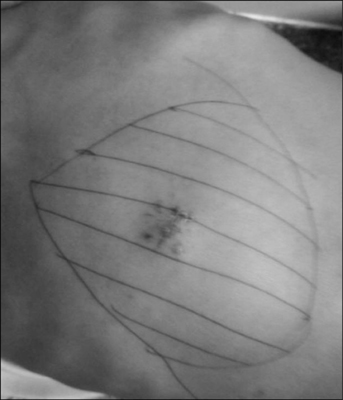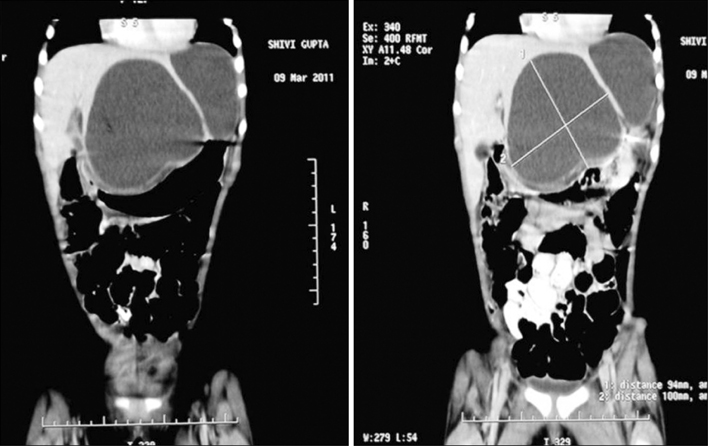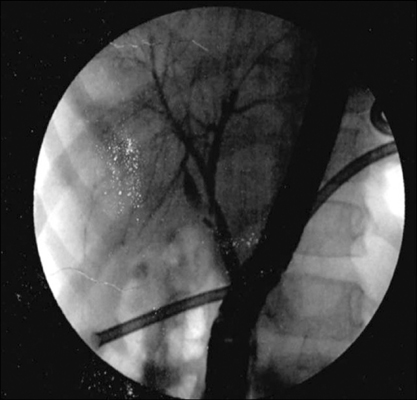Pediatr Gastroenterol Hepatol Nutr.
2016 Dec;19(4):281-285. 10.5223/pghn.2016.19.4.281.
Post Laparoscopic Cholecystectomy Biloma in a Child Managed by Endoscopic Retrograde Cholangio-Pancreatography and Stenting: A Case Report
- Affiliations
-
- 1Department of Paediatric Surgery, TNMC and BYL Nair Hospital, Mumbai Central, Mumbai, India. hemanshisshah@gmail.com
- KMID: 2364770
- DOI: http://doi.org/10.5223/pghn.2016.19.4.281
Abstract
- Laparoscopic cholecystectomy, though an uncommon surgical procedure in paediatric age group is still associated with a higher risk of post-operative bile duct injuries when compared with the open procedure. Small leaks from extra hepatic biliary apparatus usually lead to the formation of a localized sub-hepatic bile collection, also known as biloma. Such leaks are rare complication after laparoscopic cholecystectomy, especially in paediatric age group. Minor bile leaks can usually be managed non-surgically by percutaneous drainage combined with endoscopic retrograde cholangio-pancreatography (ERCP). However, surgical exploration is required in cases not responding to non-operative management. If not managed on time, such injuries can lead to severe hepatic damage. We describe a case of an eight-year-old girl who presented with biloma formation after laparoscopic cholecystectomy who was managed by ERCP.
Keyword
MeSH Terms
Figure
Reference
-
1. Oak SN, Parelkar SV, Akhtar T, Pathak R, Vishwanath N. Role of laparoscopic cholecystectomy in children. J Indian Assoc Paediatr Surg. 2005; 10:92–94.
Article2. Eum YO, Park JK, Chun J, Lee SH, Ryu JK, Kim YT, et al. Non-surgical treatment of post-surgical bile duct injury: clinical implications and outcomes. World J Gastroenterol. 2014; 20:6924–6931.
Article3. Pavlidis TE, Atmatzidis KS, Papziogas BT, Galanis IN, Koutelidakis IM, Papaziogas TB. Biloma after laparoscopic cholecystectomy. Ann Gastroenterol. 2002; 15:178–180.4. Mortelé KJ, Ros PR. Anatomic variants of the biliary tree: MR cholangiographic findings and clinical applications. AJR Am J Roentgenol. 2001; 177:389–394.5. Cervantes J, Rojas GA, Ponte R. Intrahepatic subcapsular biloma. A rare complication of laparoscopic cholecystectomy. Surg Endosc. 1994; 8:208–210.6. Vazquez JL, Thorsen MK, Dodds WJ, Quiroz FA, Martinez ML, Lawson TL, et al. Evaluation and treatment of intraabdominal bilomas. AJR Am J Roentgenol. 1985; 144:933–938.
Article7. Mansour AY, Stabile BE. Extrahepatic biliary obstruction due to post-laparoscopic cholecystectomy biloma. JSLS. 2000; 4:167–171.8. Sharda S, Sharma A, Khullar R, Soni V, Baijal M, Chowbey P. Postlaparoscopic cholecystectomy biloma in the lesser sac: a rare clinical presentation. J Minim Access Surg. 2015; 11:154–156.
Article9. Walker AT, Shapiro AW, Brooks DC, Braver JM, Tumeh SS. Bile duct disruption and biloma after laparoscopic cholecystectomy: imaging evaluation. AJR Am J Roentgenol. 1992; 158:785–789.
Article
- Full Text Links
- Actions
-
Cited
- CITED
-
- Close
- Share
- Similar articles
-
- A Case of Hepatic Biloma Following Endoscopic Retrograde Cholangiography
- Persistent air bubbles in the gallbladder after endoscopic retrograde cholangio-pancreatography
- Spontaneous Biloma Caused by Pancreatic Cancer and Treated by Endoscopic Biliary Stenting
- A Case of Bile Leak from the Accessory Bile Duct after Laparoscopic Cholecystectomy
- Endoscopic Management of Bile Leakage after Cholecystectomy: A Single-Center Experience for 12 Years




